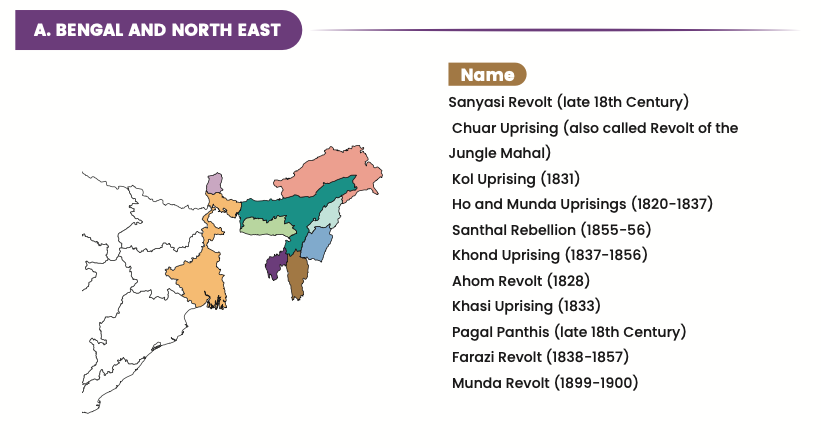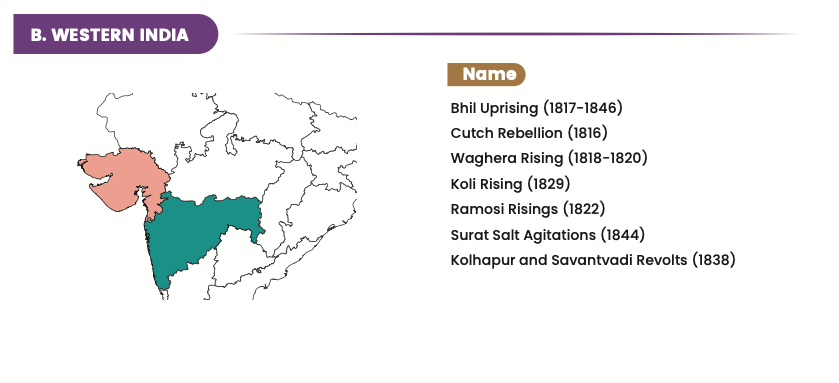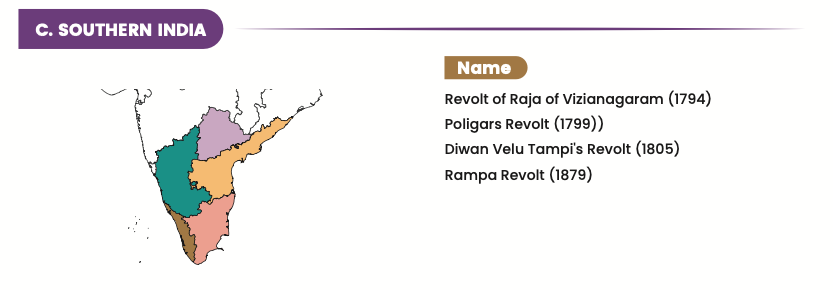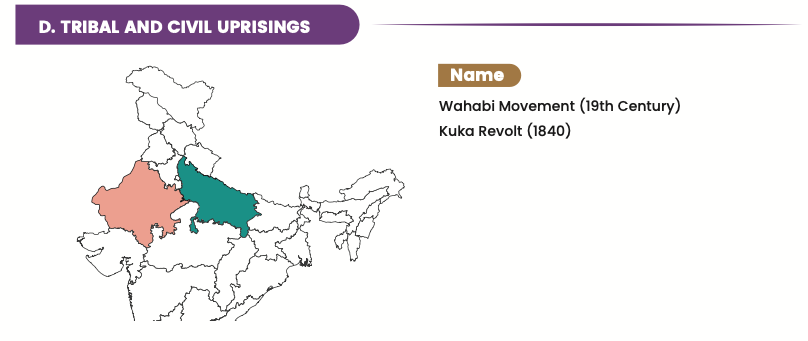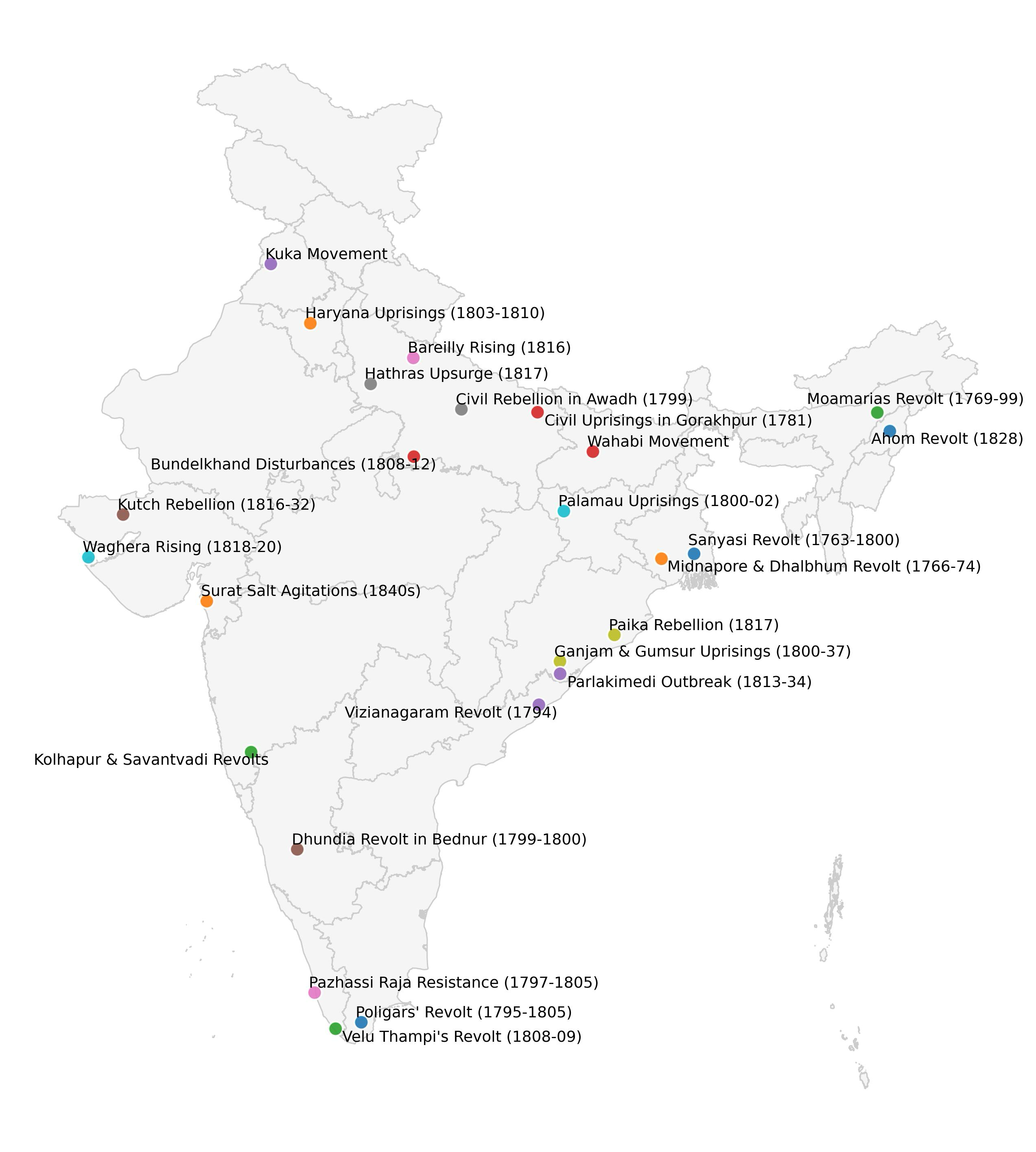6. People's Resistance against British Before 1857
- People's Resistance: Meaning and Forms
- Diverse groups (peasants, artisans, tribals, elites, soldiers, religious leaders) fought British rule
- 1810-1816: Urban tax protests united lower classes with gentry
- Four resistance forms
- Civil rebellions
- Tribal uprisings
- Peasant movements
- Military revolts
- Causes and Genesis
- Colonial rule: revenue extraction focus, no grievance mechanisms, protective laws for collaborators
- Economic factors: heavy taxes, land evictions, tribal displacement, destroyed industries
- Rural exploitation: intermediaries, revenue collectors, moneylenders
- Worker migration from industry to agriculture increased land pressure
Civil Uprising Characteristics
- Leadership: deposed rulers, zamindars, poligars, officials, religious leaders
- Support base: peasants, unemployed artisans, demobilised soldiers
- Motivations: loss of land control, status reduction, religious patronage disruption
- Nature: backward-looking, restoration-focused, locally organized
Important Civil Uprisings
Poligars
- Local warrior chiefs appointed by Vijayanagara empire
- Later retained power under Nayakas of Madurai
- Collected taxes, maintained local armies, defended territories
Ikrarnama
- Written bond of allegiance
- Sign the bond → Get sanads (leases) to continue governing the lands
| Revolt | Leader(s) | Region | Reason | Events |
|---|---|---|---|---|
| Sanyasi Revolt (1763-1800) | • Group of sanyasis • Majnun Shah • Chirag Ali • Musa Shah • Bhawani Pathak • Debi Chaudhurani |
• Eastern India | • 1770 famine • Harsh British economic policies • Land dispossession |
• Raids on Company factories and treasuries • Prolonged resistance eventually subdued by Warren Hastings |
| Revolt in Midnapore and Dhalbhum (1766-74) | • Damodar Singh • Jagannath Dhal |
• Midnapore, Dhalbhum (West Bengal) | • New land revenue system introduced in 1772 | • Zamindars sided with ryots against British revenue officials • Zamindars ultimately dispossessed by 1800s |
| Revolt of Moamarias (1769-99) | • Moamaria peasants | • Assam | • Challenge to Ahom kings' authority | • Low-caste peasant uprising • Weakened Ahom kingdom • King of Darrang revolted separately in 1792 • Eventually led to Burmese invasion and British rule |
| Civil Uprisings in Gorakhpur, Basti, and Bahraich (1781) | • Cultivators and zamindars | • Gorakhpur, Basti, Bahraich (Awadh) | • Excessive revenue demands by Major Alexander Hannay / Warren Hastings | • Rebellion against unbearable exactions • Hannay's subordinates killed or besieged • Izara forcibly removed |
| Revolt of Raja of Vizianagaram (1794) | • Raja of Vizianagaram (Viziarama Raju) | • Vizianagaram (modern Andhra Pradesh) | • British demand for tribute • Order to disband troops |
• Raja refused demands • Died in battle at Padmanabham • Territory came under Company rule |
| Revolt of Dhundia in Bednur (1799-1800) | • Dhundia Wagh (Maratha leader converted to Islam) | • Bednur, Maratha and Mysore regions | • Anti-British sentiment after Mysore conquest | • Organized anti-British force • Carved small territory • Killed fighting British forces under Wellesley |
| Resistance of Kerala Varma Pazhassi Raja (1797; 1800-05) | • Kerala Varma Pazhassi Raja (Lion of Kerala) | • Kottayam (Kerala) | • Excessive taxation • Violation of 1790 agreement recognizing independence |
• Guerrilla warfare against British • Organized Nairs, Mappillas and Pathans • Killed in 1805 |
| Civil Rebellion in Awadh (1799) | • Wazir Ali Khan (fourth Nawab of Awadh) | Awadh and Benares | • Souring relations with British after being replaced by his uncle Saadat Ali Khan II | • Killed British resident George Frederick Cherry and others in "Massacre of Benares" • Assembled army • Defeated by General Erskine • Fled to Butwal (in Nepal) • Granted asylum in Jaipur • Extradited with conditions • Confined at Fort William, Calcutta |
| Uprisings in Ganjam and Gumsur (1800, 1835-37) | • Srikara Bhanj • Jlani Deo + Jagannath Deo • Dhananjay Bhanj (son of Srikara) • Doora Bisayi (formidable leader) |
Northern Circars, Ganjam district | • Refusal to pay revenues • Oppressive British collectors |
• Multiple rebellions • Dhananjay died December 1835 • Followers continued until February 1837 • Doora Bisayi arrested • Gumsur zamindari forfeited |
| Uprisings in Palamau (1800-02) | • Bhukhan Singh (Chero chief) | Palamau and Sarguja | • Crises of agrarian landlordism • Feudal system breakdown |
• Colonel Jones camped for two years to suppress rebellion • Bhukhan died in 1802 • Insurrection calmed after leader's death |
| Poligars' Revolt (1795-1805) | • Kattabomman Nayakan (1st phase) • Oomathurai (2nd phase) • Poligar of Yedapagunta (3rd phase) |
South India (Tirunelveli, Ramanathapuram, Sivaganga, Madurai, North Arcot) | • Loss of independent sovereign authority • Excessive taxation • British treating poligars as enemies |
• First phase (1795-99): Kattabomman initially successful, later captured and hanged, lands confiscated • Second phase (1801): Poligars escaped jail, captured Tuticorin, suppressed by October 1801 • Third phase (1803-05): North Arcot poligars rebelled over kaval fees, suppressed by February 1805 |
| Uprisings in Haryana Region (1803-1810) | • Zabita Khan of Sirsa, Rania • Khan Bahadur Khan of Fatehabad |
Haryana, possessions of Scindia | • Opposition to British East India Company rule after Chapter 3 - 5#^Treaty-Of-Surji-Anjangaon | • Bhatti Rajputs and Muslims organized resistance • British sent contingent under Col. Adams in November 1809 • British victorious • Fort of Hansi converted to military cantonment |
| Diwan Velu Thampi's Revolt (1808-09) | • Velu Thampi (Prime Minister of Travancore) | Travancore state | • Harsh conditions imposed by East India Company • Excessive subsidy and arrears demands |
• Issued Kundara Proclamation calling for arms against British • Large-scale rebellion ensued • Maharaja of Travancore didn't fully support the revolt → defected to company • Velu Thampi killed himself to avoid capture |
| Disturbances in Bundelkhand (1808-12) | • Lakshaman Dawa (Ajaygarh Fort) • Gopal Singh |
Bundelkhand province (Bengal Presidency) | • Resistance to new British government after Anglo-Maratha Wars | • 150 forts resisted British authority • Lakshaman Dawa surrendered in 1809 • Gopal Singh fought for four years • British adopted Chapter 3 - 5#^ikrarnama policy to bind hereditary chieftains |
| Parlakimedi Outbreak (1813-34) | • Narayan Deo • Gajapathi Deo • Jagannath Deo |
Western Ganjam (now in Odisha) | • Resistance from zamindars and rajas against Company acquisition | • Multiple revolts over two decades • George Russell appointed commissioner with full powers • Region finally pacified by 1834 |
| Kutch Rebellion (1816-32) | • Raja Bharmal II • Later various chieftains |
Kutch | • Power struggle between maharaja and chieftains • British interference in local governance |
• Raja raised Arab and African troops to remove British • British defeated and deposed him • Installed infant son with British resident • Administrative innovations and land assessment caused resentment • Burma War emboldened chiefs to resist • British eventually adopted conciliatory policy |
| Rising at Bareilly (1816) | • Mufti Muhammad Aiwaz | Bareilly | • Police tax imposition • Religious grievances |
• Mufti petitioned magistrate against tax • Police injured woman during tax collection • Bloody scuffle ensued • Muslims from multiple towns joined rebellion • Insurgents murdered judge's son • Over 300 rebels killed • British concluded discontent was more about alien administration than specific grievances |
| Upsurge in Hathras (1817) | Dayaram (talukdar) | Hathras fort, Aligarh district | • Increasing high revenues • Failure to pay arrears |
• Dayaram fortified in Hathras ("second Bharatpur") fort • Fought British for 15 days • Eventually captured and settled with pension • Bhagwant Singh (another rebel) submitted |
| Paika Rebellion (1817) | Bakshi Jagabandhu Bidyadhar | Odisha (Khurda territory) | • Loss of traditional land tenures • Extortionist revenue policy • Salt taxes • Cowrie currency abolition |
• Jagabandhu led Paikas and zamindars • Forced Company to retreat • Rebellion spread across Odisha • Brutally repressed by 1818 • Jagabandhu surrendered in 1825 • Achieved concessions including arrears remission and fixed tenures |
| Waghera Rising (1818-20) | Waghera chiefs of Okha Mandal | Baroda | • Resentment against alien rule • Reactions against Gaekwad of Baroda |
• Wagheras raided British territory • Peace treaty signed in November 1820 |
| Ahom Revolt (1828) | • Gomdhar Konwar (Ahom prince) • Dhanjay Borgohain • |
Assam | • British attempt to incorporate Ahom territories after First Burma War | • Rebellion with support of compatriots (Dhanjay Borgohain, Jairam Khargharia Phukan) • Company eventually adopted conciliatory policy • Upper Assam restored to Assamese king |
| Surat Salt Agitations (1840s) | Surat | • British raising salt duty from 50 paise to one rupee • Additional salt levy |
• Local population attacked Europeans in 1844 • Popular boycott movement • Government withdrew measure in 1848 |
|
| Kolhapur and Savantvadi Revolts | Gadkaris (hereditary military class) | Kolhapur state, Savantvadi | • Unemployment due to disbanding of Maratha forts • British deposing ruler |
• Gadkaris occupied Samangarh and Bhudargad forts • British introduced laws to control the region |
| Wahabi Movement | Syed Ahmed of Rai Bareilly | Patna, Hyderabad, Madras, Bengal, United Provinces, Bombay, Sithana | • Islamic revivalist movement against Western influence | • Organized with spiritual vice-regents • Declared jihad against Sikh kingdom • After 1849, targeted British • Military operations in 1860s weakened movement • Sporadic resistance continued into 1890s |
| Kuka Movement | Bhagat Jawahar Mal (Sian Saheb), later Baba Ram Singh | Western Punjab | • Religious purification transformed to political campaign against British | • Advocated social reforms, swadeshi, boycott of British products • British took steps to crush movement (1863-1872) • Ram Singh deported to Rangoon |
Peasant Movement with Religious Overtones
| Revolt | Leader(s) | Region | Reason | Events |
|---|---|---|---|---|
| Narkelberia Uprising | Mir Nithar Ali (1782-1831)/Titu Mir | West Bengal | • Protest against beard-tax on Faraizis • Opposition to Hindu landlords and British indigo planters |
• First armed peasant uprising against British • Took on religious character • Merged with Wahabi Movement |
| Pagal Panthis | Tipu (son of Karam Shah) | Mymensingh district (earlier Sherpur) | • Fight oppression of zamindars • Limit rent payments |
• 1825-1835: Refused rent above certain limit • Government introduced equitable arrangement • Later violently suppressed |
| Faraizi Revolt | Haji Shariatullah of Faridpur, later Dudu Mian (1819-1862) | Eastern Bengal | • Religious, social, political changes • Oppose foreign intruders |
• Supported tenant cause against zamindars • Continued 1838-1857 • Many joined Wahabi ranks |
| Moplah Uprisings | Local Moplah leaders (initially); later organized movements involved Congress and Khilafat supporters | Malabar | • Demand rent reduction • Reduce field size • Oppose official oppression |
• Twenty-two rebellions between 1836-1854 • None successful • Hindu-Muslim differences distanced Congress from Moplahs by 1921 • Thousands of Hindus murdered and forcibly converted to Islam |
| Peasants in 1857 Revolt | Local feudal leaders | Western Uttar Pradesh primarily | • Fight foreign rule • Improve peasant conditions |
• Limited active participation • Post-revolt: peasants ignored • Land restored to taluqdars • Occupancy rights suffered • Punitive taxes imposed via 1859 Bengal Rent Act |
Tribal Revolts
- Tribal Revolts: Most frequent and militant movements under British rule
- Mainland vs Northeast Tribal Revolts
- Mainland: Sparked by land issues, British settlements disrupted joint ownership, forest restrictions, exploitation by outsiders
- Northeast: Cross-border cultural links, sought autonomy/independence, not forest-based, revolts lasted longer, anti-Brahmin movements
- Common Characteristics
- Ethnic solidarity, targeted moneylenders/traders not poor villagers
- Common cause
- Resentment against "foreign government" laws destroying traditional socio-economic framework
- Erosion of tribal rights over land and forest
- Land alienation as non-tribe people took over land, especially after roads and railways built
- Many uprisings led by messiah-like figures promising end to suffering
- Tribal uprisings doomed from beginning due to outdated arms against modern weapons
Important Mainland Tribal Movements
Tribal
- Tilka Majhi → First Adivasi leader to take up arms agains the British
| Rebellion | Leaders | Region | Reasons | Key Events |
|---|---|---|---|---|
| Pahariyas Rebellion (1778) | • Raja Jagannath | • Rajmahal hills • Areas where shifting cultivation was practiced |
• British expansion of settled agriculture reduced forest areas • Disruption of traditional subsistence patterns • Historical independence through geographical isolation • Hostility toward outsiders |
• 1770s: British hunted down Pahariyas • 1778: British initiated pacification policy with annual allowances to chiefs • Some chiefs withdrew into mountains, continuing resistance against dikus (outsiders) |
| Tilka Manjhi Revolt (1784-85) | • Tilka Manjhi (Jabra Paharia) | • Santhal Pargana • Hills around Sultanganj • Jungles of Tarai region |
• Opposition to British divide and rule policy • Exploitation by revenue collectors • Drought of 1770 leading to starvation |
• Attacked East India Company boats on Ganga • Organized guerrilla warfare with Santhal women participating • 1784: Captured Ramgarh Camp, attacked Bhagalpur • 1785: Captured and hanged by British |
| Chuar Uprising (1768-99) | • Jagannath Singh (1768) • Chuar sardars including Shyam Ganjan, Subla Singh, Dubraj (1771) • Durjan Singh (1798) • Madhab Singh, Raja Mohan Singh, Lachman Singh |
• Jungle/Jungal Mahals between Chota Nagpur and Bengal plains • Birbhum, Bankura, Midnapore • Inhabited by Bhumij tribals |
• Increased revenue demands • British Permanent Settlement policies • Demolition of mud forts • Replacement of local paiks with professional police • Clash between tribal and colonial ways of life |
• 1768: Jagannath Singh led uprising, Company capitulated • 1771: Chuar sardars rebelled but were suppressed • 1798: Major uprising under Durjan Singh • May 1798: 1,500 Chuars attacked Raipur auction • 1799: British brutally suppressed the revolt |
| Tamar Revolt (1798) | • Bholanath Sahay/Singh | • Chotanagpur region | • Reaction to faulty and alien systems imposed by British • Anger against dikus (outsiders) |
• Munda tribals and chiefs joined forces with Bholanath • Firmly suppressed by expedition led by Lt. Cooper • Several more revolts followed |
| Kol Mutiny (1831) | • Buddho Bhagat | • Chhotanagpur covering Ranchi, Singhbhum, Hazaribagh, Palamau, western parts of Manbhum | • Large-scale land transfers from Kol headmen to outsiders (Hindu, Sikh, Muslim farmers and moneylenders) • Oppressive taxation • British judicial and revenue policies affecting traditional social conditions |
• 1831: Kol rebels killed or burnt about a thousand outsiders • Suppressed only after large-scale military operations |
| Ho and Munda Uprisings (1820-37) | • Raja of Parahat organized Ho tribals | • Singhbhum (now in Jharkhand) | • Occupation of tribal lands • Newly introduced farming revenue policy • Entry of Bengalis into their region |
• 1820-27: Continuous revolt until Ho tribals forced to submit • 1831: Second rebellion with Mundas of Chotanagpur • Revolt extinguished but operations continued till 1837 |
| Santhal Rebellions (1833, 1855-56) | • Sidhu and Kanhu (two brothers) • Supported by Phulo and Jhano Murmu (Sisters of Sidhu and Kanhu) |
• Rajmahal area • Bhagalpur to Rajmahal |
• Loss of land due to Permanent Settlement Act of 1793 • Heavy taxes • Debt exploitation by moneylenders • Land seizures • Displacement from Damin-i-koh |
• 1832-1833: British created Damin-i-koh for Santhals, forcing Paharias to higher hills • 1850s: "Hul" (liberation movement) against zamindars, moneylenders, British • Declared autonomous area between Bhagalpur and Rajmahal • Used sajji branches for secret communication • 1856: British suppressed rebellion with military force, burning villages, using elephants, killing thousands • Sidhu and Kanhu killed • Santhal Pargana created from districts of Bhagalpur and Birbhum • Prohibited transfer of Santhal owned land to non Santhals |
| Khond Uprisings (1837-56) | • Chakra Bisoi, a young raja | • Hilly tracts extending from Odisha to Srikakulam and Visakhapatnam districts of Andhra Pradesh | • Opposition to suppression of human sacrifice • New taxes • Entry of zamindars into tribal areas |
• Ghumsar, Kalahandi, and other tribes joined the uprising • Rebellion ended with Chakra Bisoi's disappearance |
| Koya Revolts (1803-86) | • Tomma Sora (1879-80) • Raja Anantayyar (1886) |
• Eastern Godavari tract (modern Andhra) | • Oppression by police and moneylenders • New regulations • Denial of customary rights over forest areas |
• Multiple rebellions in 1803, 1840, 1845, 1858, 1861, 1862, 1879-80, 1886 • Joined by Khonda Sara chiefs in earlier revolts • 1879-80 uprising after Tomma Sora's death |
| Bhil Revolts (1817-46) | • Govind Guru (by 1913) | • Western Ghats, mountain passes between north and Deccan • South Rajasthan (Banswara, Sunth states) |
• Famine • Economic distress • Misgovernment |
• Multiple rebellions in 1817-19, 1825, 1831, 1846 • British used force and conciliatory efforts • Bhils organized themselves to fight for a Bhil Raj by 1913 |
| Koli Risings (1829-48) | • Neighborhood of Bhils | • Imposition of Company rule • Large-scale unemployment • Dismantling of forts |
• Rebellions in 1829, 1839, 1844-48 • Multiple uprisings over two decades |
|
| Ramosi Risings (1822-41) | • Chittur Singh (1822) • Umaji Naik of Poona and Bapu Trimbakji Sawant (1825-26) • Raja Pratap Singh of Satara (1839) |
• Western Ghats • Maratha territories |
• Loss of livelihood after annexation of Maratha territories • Policy of annexation |
• 1822: Rose under Chittur Singh, plundered country around Satara • 1825-26: Eruptions led by Umaji Naik • 1839: Deposition of Raja Pratap Singh triggered revolt • 1840-41: Further disturbances suppressed by British |
Tribal Revolts after 1857
| Rebellion | Leaders | Region | Reasons | Key Events |
|---|---|---|---|---|
| Bokta Rising, Sardari Larai or Mukti Larai (1858-1895) | • Not specifically named • Lacked organization and good leadership |
• Chotanagpur | • Regaining tribal rights over land • Increased rent • Eviction from land • Harassment by landlords • Later opposition to Europeans suspected of colluding with landlords |
• Early phases: tribal tenants rose against landlords • 1890s: movement turned against all Europeans • Tribes used traditional weapons (bows and arrows) when constitutional methods failed |
| Birsa Munda Revolt "Ulgulan" (Great Tumult) (1890s-early 1900s) | • Birsa Munda | • Munda tribes of Singhbhum and Ranchi districts in Chotanagpur | • Permanent Settlement Act 1793 abolished Khuntkatti • Khuntkatti: Traditional Munda system of joint land ownership by clan families who cleared the land • Forced rent payments led to dependence on moneylenders • Harassment by landlords • Forced labor (begar) • Goal to attain religious and political independence |
• Birsa's arrest and two-year imprisonment strengthened rebel resolve • December 1899: revolt broke out against dikus (outsiders) • 1900: Birsa arrested, died of illness • Many rebels imprisoned or executed • 1903: Government abolished compulsory begar, passed Tenancy Act • 1908: Specific Sectoral Regulations#Chota Nagpur Tenancy Act 1908 passed |
| Tana Bhagat Movement (1914-1919) | • Jatra Oraon (proclaimed himself divinely ordained king) • Later led by Sibu Oraon (1919) |
• Jharkhand (Ranchi) | • Agrarian discontent against begar • Illegal rent increases by zamindars • Opposition to moneylenders and missionaries |
• Followers called to discard earthly possessions • Rejected spirit worship and sacrifice • Conducted satyagraha before Gandhi's movement • Primarily religious and nonviolent • 1921: drawn into Congress fold during Non-Cooperation Movement |
| Devi Movement (1922-1923) | • Inspired by Devi Salabai | • South Gujarat • Surat city |
• Initially social reform (abstaining from flesh, liquor, promoting cleanliness) • Later targeted exploitative classes (landlords, moneylenders, liquor traders) |
• December 1922: movement spread across tribal regions • Became part of Non-Cooperation Movement by end of 1922 |
Tribal Movements of North East
| Uprising | Leaders | Place | Cause | Events |
|---|---|---|---|---|
| Khasi Uprising | • Tirath Singh led Khasis, Garos, Khamptis, and Singphos | • Hilly region between Garo and Jaintia Hills | • East India Company's road construction linking Brahmaputra Valley with Sylhet • Influx of outsiders |
• Tribes organized to drive away outsiders • Developed into popular revolt • Suppressed by 1833 • Superior English military force suppressed it |
| Singphos Rebellion | • Chief Nirang Phidu led 1843 uprising | • Assam | • British occupation | • Multiple rebellions against British (1830, 1839, 1843) • 1830 rebellion quickly quelled • 1839 uprising killed British political agent • 1843 attack on British garrison killed many soldiers |
Tribal Movement of North East → Before 1957
| Rebellion | Leaders | Region | Reason | Events |
|---|---|---|---|---|
| Ahoms' Revolt (1828-33) | Assam | • Non-fulfillment of Company pledges after Burmese War | • Uprising suppressed by Company dividing the kingdom | |
| Khasis' Revolt (1830s) | Tirath Singh (Nunklow ruler) | Hilly region between Jaintia and Garo Hills | • Against occupation of hilly region | • Resistance to British territorial expansion |
| Singphos' Rebellion (1830s) | Not specified | Assam | • Not explicitly stated | • British political agent murdered in 1839 • Ultimately suppressed |
Tribal Movement of North East → After 1957
| Rebellion | Leaders | Region | Reason | Events |
|---|---|---|---|---|
| Kukis' Revolt (1917-19) | Manipur | • Against British labor recruitment during WWI | ||
| Revolts in Tripura (1863-1940s) | • Parikshit Jamatia (1863) • Ratnamani (1942-43) • Bharti Singh (1920s) |
Tripura | • Against house tax increases • Against outsider settlements |
|
| Zeliangsong Movement (1920s) | Zemi, Liangmei and Rongmei tribes | Manipur | • British failure to protect during Kuki violence | |
| Naga movement (1905-31) | Jadonang | Manipur | • Against British rule • For establishing Naga raj |
• Early Naga independence movement |
| Heraka Cult (1930s) | Gaidinliu | Manipur | • Suppressed but led to Kabui Naga Association in 1946 |
Important Mutinies (Pre-1857)
- 1764: Sepoy mutiny in Bengal
- 1806: Vellore mutiny, sepoys protested religious interference, raised Mysore ruler's flag
- 1824: Mutiny of 47th Native Infantry Unit
- 1825: Grenadier Company revolt in Assam
- 1838: Indian regiment mutiny at Sholapur
- Multiple Native Infantry mutinies: 34th N.I. (1844), 22nd N.I. (1849), 66th N.I. (1850), 37th N.I. (1852)
- All mutinies remained localized, ruthlessly crushed by British authorities
- British response included violence, executing leaders, disbanding regiments
- These revolts' legacy proved significant later
Weaknesses of People's Uprisings
- Despite large participation, uprisings were localized and occurred at different times in different regions
- Primarily arose from local grievances
- Leadership was semi-feudal, backward-looking, traditional in outlook
- Resistance offered no alternatives to existing social structures
- Similar anti-colonial sentiment stemmed from common conditions, not national unity
- Rebellions maintained centuries-old forms and ideological/cultural content
- Less obstinate participants were pacified through concessions
- Fighters used obsolete methods and arms compared to British weapons, strategy, deception
